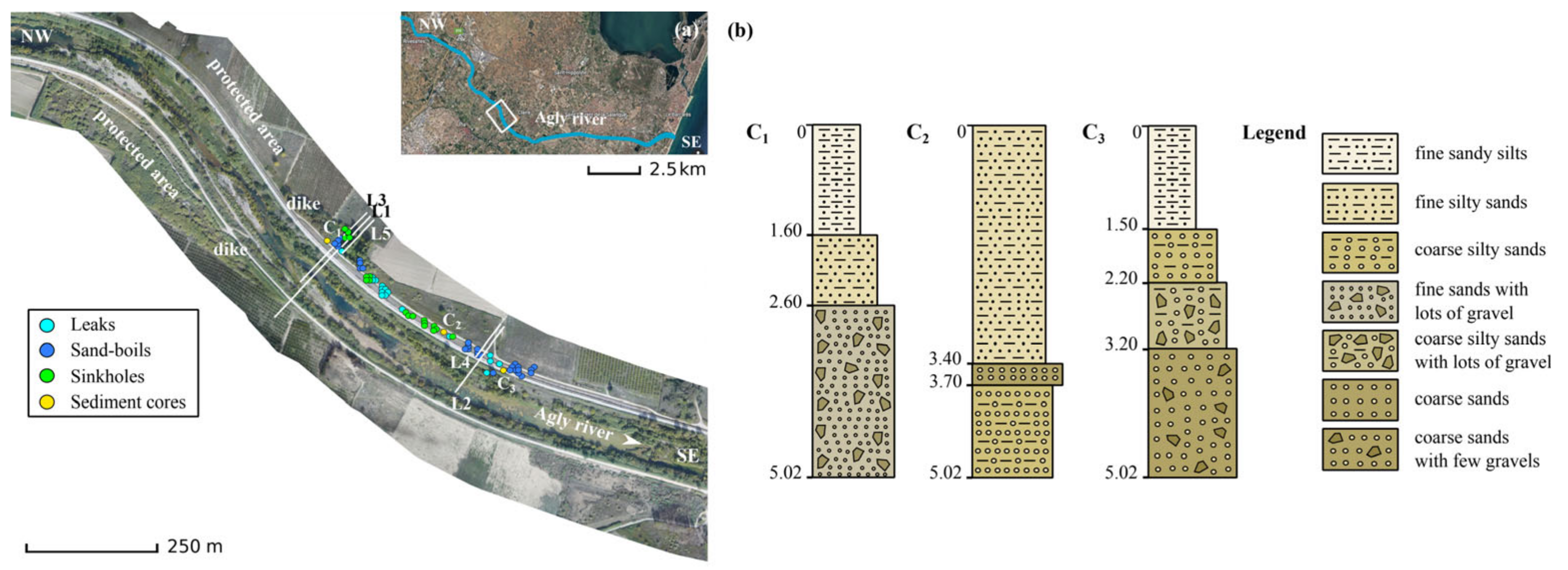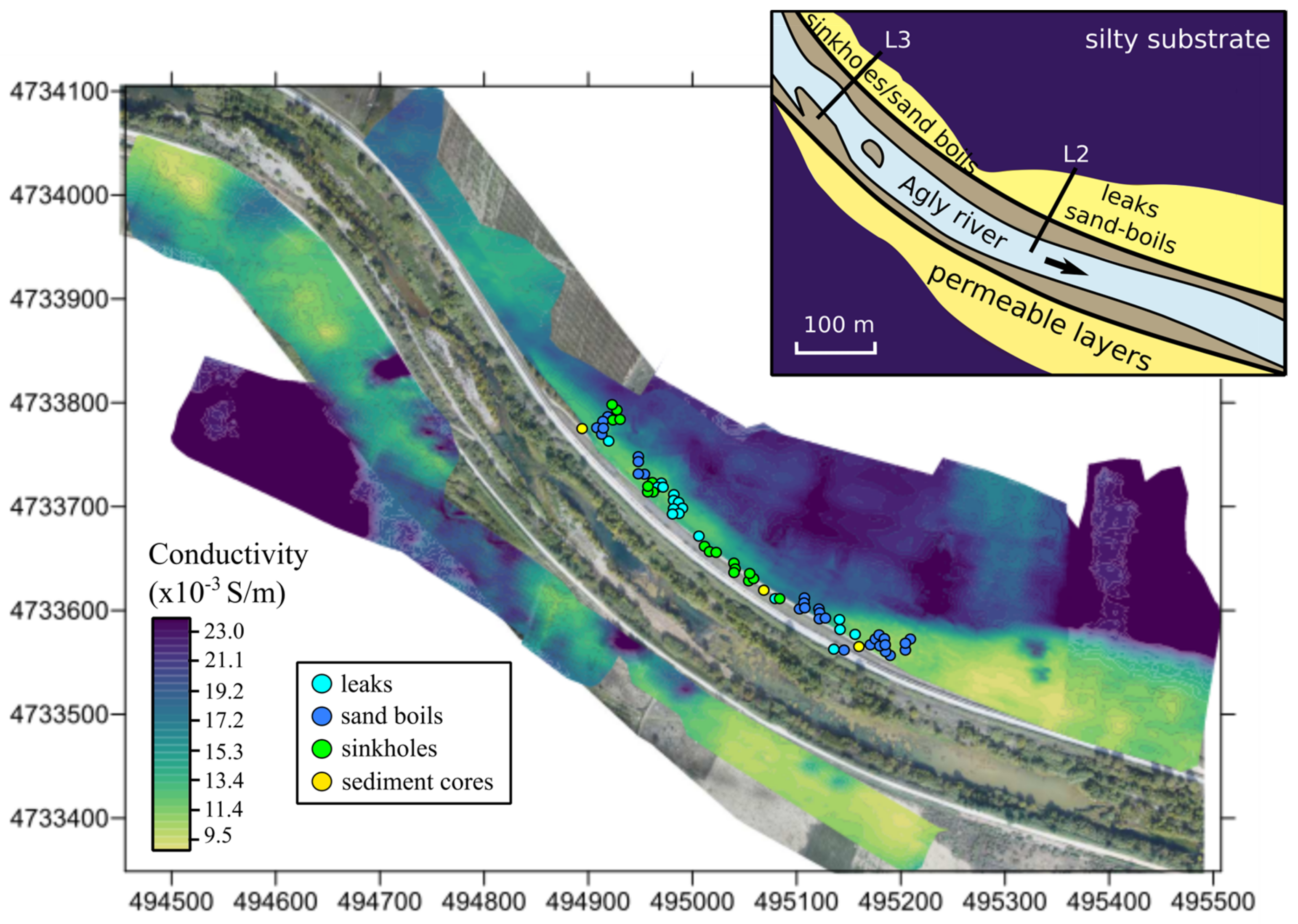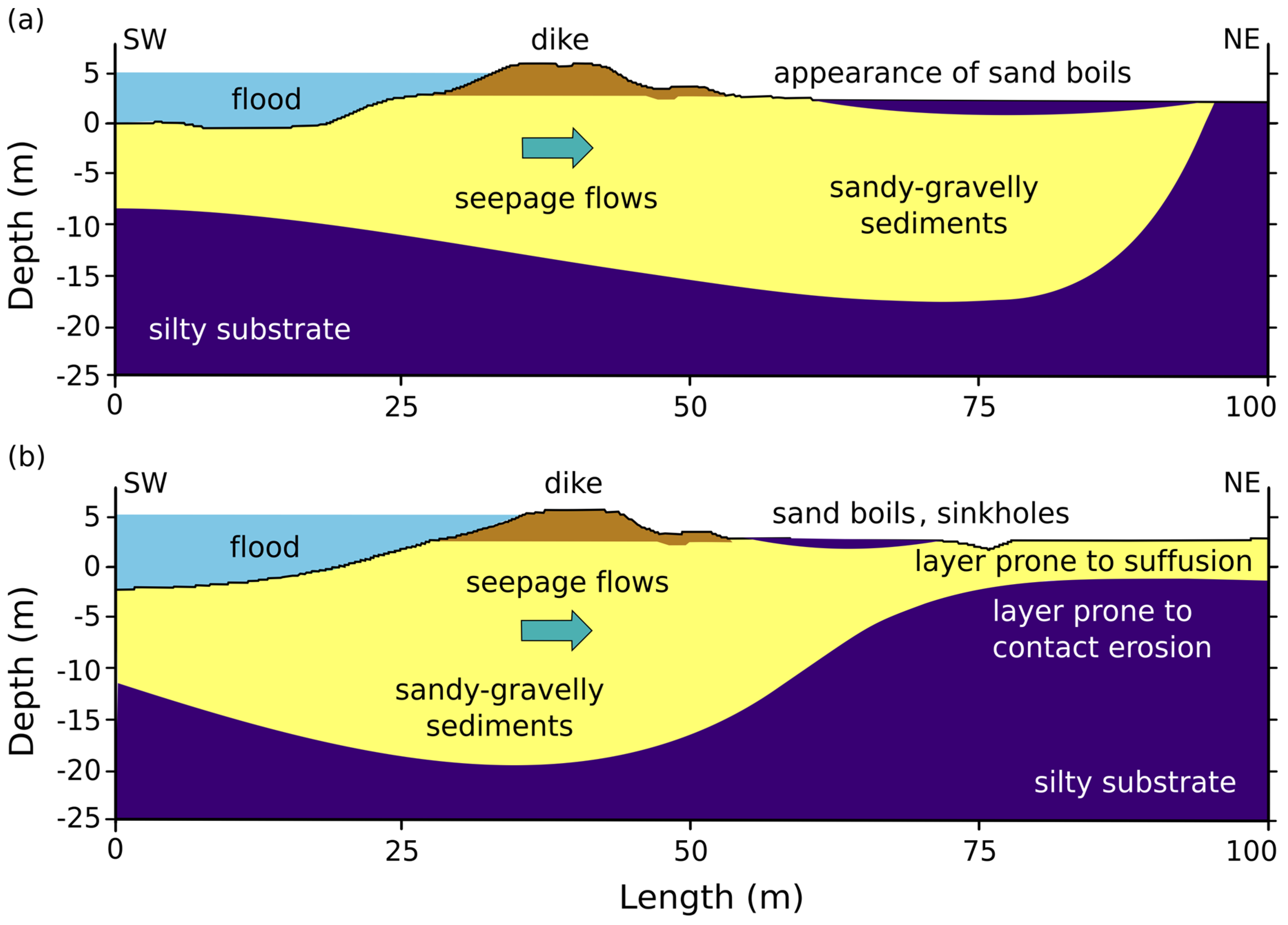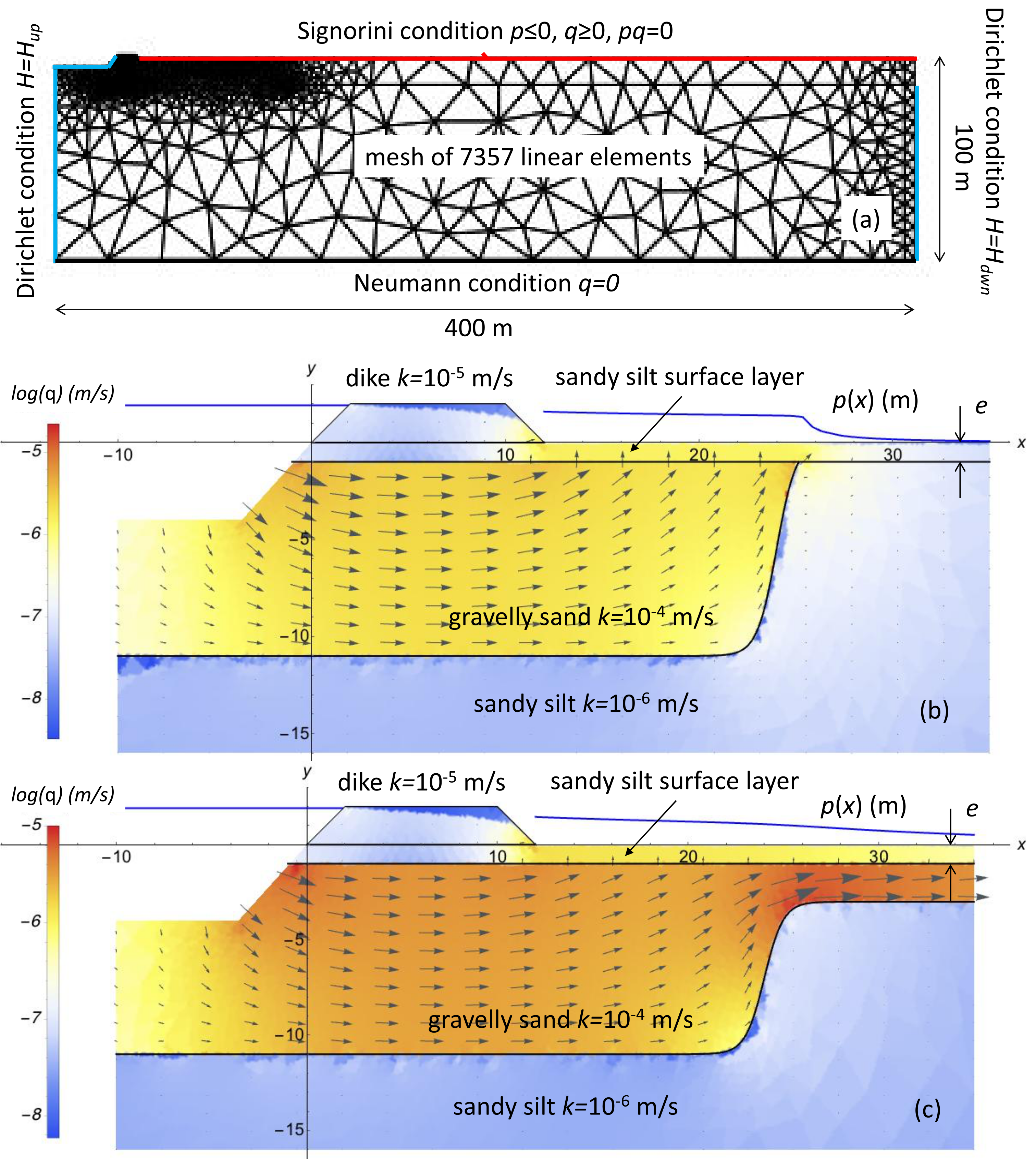On Internal Erosion of the Pervious Foundation of Flood Protection Dikes
Abstract
:1. Introduction
2. Sand Boils and Sinkholes along the Agly Dikes
3. Materials and Methods
3.1. Description of Geophysical Methods
3.2. Testing Protocols Followed on the Field
4. EMI and ERT Results
4.1. EMI Results
4.2. ERT Results
- -
- an area of conductivity measurements below 5×10−4 S/m located on the minor bed and beneath the northern and southern embankments, indicating a permeable soil layer that corresponds to old sediments that fill a paleo-valley,
- -
- an area with measurements of conductivity above 7×10−3 S/m located in depth, indicating a less-permeable soil layer that corresponds to a sandy-marly substrate, which includes the groundwater at the time of measurements.
5. Results Analysis
5.1. Analysis of EMI Results
- -
- a sandy, permeable layer (paleo-sediments) that expand from the levee toe, to up to a few tens of meters on the protected area where leaks and sand boils are observed after each flooding event.
- -
- a sandy, permeable layer (paleo-sediments) extending from the levee toe to up to around 20 m on the plain where leaks, sand boils and sinkholes were observed after the 2013 flooding event.
5.2. Analysis of ERT Results on Leaks and Sand Boils Locations
5.3. Analysis of ERT Results on Leaks, Sand Boils and Sinkholes Locations
6. Discussion
6.1. Remarks on the Influence of Temperature and Water Content on Resistivity Variations
6.2. Numerical Modeling: Example of Results and Comments on Hydraulic Modeling Based on ERT Measurements
7. Conclusions
Author Contributions
Funding
Data Availability Statement
Acknowledgments
Conflicts of Interest
References
- Foster, M.; Fell, R.; Spannagle, M. The statistics of embankment dam failures and accidents. Can. Geotech. J. 2000, 37, 1000–1024. [Google Scholar] [CrossRef]
- Danka, J.; Zhang, L.M. Dike failure mechanisms and breaching parameters. J. Geotech. Geoenviron. Eng. 2015, 141, 04015039. [Google Scholar] [CrossRef]
- Amin, A.; Girolami, L.; Risso, F. On the fluidization/sedimentation velocity of a homogeneous suspension in a low-inertia fluid. Powder Technol. 2021, 391, 1–10. [Google Scholar] [CrossRef]
- Fell, R.; Fry, J.-J. (Eds.) Internal Erosion of Dams and Their Foundations; Taylor & Francis: London, UK, 2007. [Google Scholar]
- Bonelli, S. (Ed.) Erosion of Geomaterials; John Wiley & Sons: Hoboken, NJ, USA, 2012; 371p. [Google Scholar]
- Bonelli, S. (Ed.) Erosion in Geomechanics Applied to Dams and Levees; John Wiley & Sons: Hoboken, NJ, USA, 2013; 388p. [Google Scholar]
- Zwanenburg, C.; López-Acosta, N.P.; Tourment, R.; Tarantino, A.; Pozzato, A.; Pinto, A. Lessons Learned from Dike Failures in Recent Decades. Int. J. Geoengin. Case Hist. 2017, 4, 203–229. [Google Scholar]
- Van, M.A.; Rosenbrand, E.; Tourment, R.; Smith, P.; Zwanenburg, C. Failure paths for levees. International Society of Soil mechanics and Geotechnical Engineering (ISSMGE)—Technical Committee TC201 ‘Geotechnical aspects of dikes and levees’. 2022. [Google Scholar]
- Richards, K.S.; Reddy, K.R. Critical appraisal of piping phenomena in earth dams. Bull. Eng. Geol. Environ. 2007, 66, 381–402. [Google Scholar] [CrossRef]
- Holzer, T.L.; Clark, M.M. Sand boils without earthquakes. Geology 1993, 21, 873–876. [Google Scholar] [CrossRef]
- van Beek, V.M. Backward Erosion Piping: Initiation and Progression. Ph.D. Thesis, Technische Universiteit Delft, Delft, The Netherlands, 2015. [Google Scholar]
- Robbins, B.A.; van Beek, V.M. Backward erosion piping: A historical review and discussion of influential factors. In Proceedings of the ASDO Dam Safety Conference, New Orleans, LA, USA, 13–17 September 2015; pp. 1–20. [Google Scholar]
- Luo, G.; Rice, J.D.; Peng, S.; Cao, H.; Pan, H.; Xu, G. Modelling Initiation Stage of Backward Erosion Piping through Analytical Models. Land 2022, 11, 1970. [Google Scholar] [CrossRef]
- Pan, H.; Rice, J.D.; Peng, S.; Cao, H.; Luo, G. Analytical Modeling with Laboratory Data and Observations of the Mechanisms of Backward Erosion Piping Development. Water 2022, 14, 3420. [Google Scholar] [CrossRef]
- DeHaan, H.; Stamper, J.; Walters, B. Mississippi River and Tributaries System 2011 Post-Flood Report; USACE, Mississippi Valley Division: Vicksburg, MS, USA, 2012. [Google Scholar]
- Glynn, E.; Quinn, M.; Kuszmaul, J. Predicting piping potential along Middle Mississippi River Levees. In Proceedings of the 6th International Conference on Scour and Erosion, Paris, France, 27–31 August 2012; pp. 1473–1480. [Google Scholar]
- Semmens, S.N.; Zhou, W. Evaluation of environmental predictors for sand boil formation: Rhine–Meuse Delta, Netherlands. Environ. Earth Sci. 2019, 78, 1–11. [Google Scholar] [CrossRef]
- Wolff, T.F. Performance of Levee Underseepage Controls: A Critical Review; Rep. No. ERDC/GSL TR-02-19; USACE: Washington, DC, USA, 2002. [Google Scholar]
- Garcia Martinez, M.F.; Tonni, L.; Marchi, M.; Tozzi, S.; Gottardi, G. Numerical Tool for Prediction of Sand Boil Reactivations near River Embankments. J. Geotech. Geoenviron. Eng. 2020, 146, 06020023. [Google Scholar] [CrossRef]
- Gutierrez, F. Sinkhole Hazards. In Oxford Research Encyclopedia of Natural Hazard Science; Oxford University Press: Oxford, UK, 2016; pp. 1–92. [Google Scholar]
- Nguyen, T.K.; Benahmed, N.; Hicher, P.Y.; Nicolas, M. The Influence of Fines Content on the Onset of Instability and Critical State Line of Silty Sand. In Bifurcation and Degradation of Geomaterials in the New Millennium, IWBDG 2014; Chau, K.T., Zhao, J., Eds.; Springer Series in Geomechanics and Geoengineering; Springer: Berlin/Heidelberg, Germany, 2015. [Google Scholar]
- Valois, R.; Camerlynck, C.; Dhemaied, A.; Guerin, R.; Hovhannissian, G.; Plagnes, V.; Rejiba, F.; Robain, H. Assessment of doline geometry using geophysics on the Quercy plateau karst (South France). Earth Surf. Process. Landf. 2011, 36, 1183–1192. [Google Scholar] [CrossRef]
- Philippe, P.; Beguin, R.; Faure, Y.H. Contact erosion. In Erosion in Geomechanics Applied to Dams and Levees; John Wiley & Sons: Hoboken, NJ, USA, 2013; pp. 101–192. [Google Scholar]
- Bianchi, E.; Borgatti, L.; Vittuari, L. The Medium- to Long-Term Effects of Soil Liquefaction in the Po Plain (Italy). In Engineering Geology for Society and Territory; Lollino, G., Ed.; Springer International Publishing: Cham, Switzerland, 2015; Volume 6, pp. 421–425. [Google Scholar]
- Morton, L.W.; Olson, K.R. Sinkholes and sand boils during 2011 record flooding in Cairo (Illinois). J. Soil Water Conserv. 2015, 70, 49A–54A. [Google Scholar] [CrossRef]
- Garner, S.J.; Fannin, R.J. Understanding internal erosion: A decade of research following a sinkhole event. Hydropower Dams Int. 2010, 17, 93–98. [Google Scholar]
- Yin, Z.-Y.; Yang, J.; Laouafa, F.; Hicher, P.-Y. A framework for coupled hydro-mechanical continuous modelling of gap-graded granular soils subjected to suffusion. Eur. J. Environ. Civ. Eng. 2023, 27, 2678–2699. [Google Scholar] [CrossRef]
- Dezert, T.; Fargier, Y.; Palma Lopes, S.; Cote, P. Geophysical and Geotechnical methods for fluvial levee investigation: A review. In Engineering Geology; Elsevier: Amsterdam, The Netherlands, 2019; 18p. [Google Scholar]
- Karim, M.Z.; Tucker-Kulesza, S.E.; Rutherford, C.J.; Bernhardt-Barry, M. Geophysical Engineering to Identify Seepage Channels in the Hager Slough Levee. In Eighth International Conference on Case Histories in Geotechnical Engineering; Geotechnical Special Publications GSP 311; American Society of Civil Engineers: Reston, VA, USA, 2019. [Google Scholar]
- Tourment, R.; Benahmed, N.; Nicaise, S.; Meriaux, P.; Salmi, A.; Rougé, M. Lessons learned on the damaged on the levees of the Agly River, analysis of the sand-boils phenomena, Q. 103 R.21. In Proceedings of the 26th ICOLD Congress, Vienna, Austria, 1–7 July 2018. [Google Scholar]
- Puig, C.; Carozza, J.-M. Les changements de tracés des cours d’eau d’après les sources historiques et géomorphologiques dans la plaine du Roussillon depuis le XIIe siècle: Approche théorique et premiers résultats. In Les Plaines Littorales en Méditerranée Nord-Occidentale, Regards Croisés D’histoire, D’archéologie et de Géographie, de la Protohistoire au Moyen Age; Ropiot, V., Puig, C., Mazière, F., Eds.; Monique Mergoil: Paris, France; pp. 297–312.
- Blanchy, G.; Saneiyan, S.; Boyd, J.; McLachlan, P.; Binley, A. ResIPy, an intuitive open source software for complex geoelectrical inversion/modeling. Comput. Geosci. 2020, 137, 104423. [Google Scholar] [CrossRef]
- Côté, S. Internal Stability Criteria for Low-Plasticity Materials Subjected to Water Flow. Master’s Thesis, University of Laval, Québec, QC, Canada, 2010; 237p. (In French). [Google Scholar]
- Valois, R.; Galibert, P.Y.; Guerin, R.; Plagnes, V. Application of combined time-lapse seismic refraction and electrical resistivity tomography to the analysis of infiltration and dissolution processes in the epikarst of the Causse du Larzac (France). Near Surf. Geophys. 2016, 14, 13–22. [Google Scholar] [CrossRef]
- Chavez Olalla, J.; Winkels, T.G.; Ngan-Tillard, D.J.M.; Heimovaara, T.J. Geophysical tomography as a tool to estimate the geometry of soil layers: Relevance for the reliability assessment of dikes. Georisk Assess. Manag. Risk Eng. Syst. Geohazards 2022, 16, 678–698. [Google Scholar] [CrossRef]










| ERT Profiles | Equipment | Electrodes Spacing– Length | Array Type | Measurements Nb per Profile | Period of Measurements |
|---|---|---|---|---|---|
| L1 | IRIS Syscal Pro | 2–238 m | Wenner–Schlumberger | 3254 | Spring 2023 |
| L2, L3 | ABEM SAS4000 | 2–126 m | Wenner-α | 472 | Spring 2023 |
| L4, L5 | ABEM LS 2 | 1–63 m | Wenner-α | 472 | Spring 2022 |
Disclaimer/Publisher’s Note: The statements, opinions and data contained in all publications are solely those of the individual author(s) and contributor(s) and not of MDPI and/or the editor(s). MDPI and/or the editor(s) disclaim responsibility for any injury to people or property resulting from any ideas, methods, instructions or products referred to in the content. |
© 2023 by the authors. Licensee MDPI, Basel, Switzerland. This article is an open access article distributed under the terms and conditions of the Creative Commons Attribution (CC BY) license (https://creativecommons.org/licenses/by/4.0/).
Share and Cite
Girolami, L.; Bonelli, S.; Valois, R.; Chaouch, N.; Burgat, J. On Internal Erosion of the Pervious Foundation of Flood Protection Dikes. Water 2023, 15, 3747. https://doi.org/10.3390/w15213747
Girolami L, Bonelli S, Valois R, Chaouch N, Burgat J. On Internal Erosion of the Pervious Foundation of Flood Protection Dikes. Water. 2023; 15(21):3747. https://doi.org/10.3390/w15213747
Chicago/Turabian StyleGirolami, Laurence, Stéphane Bonelli, Rémi Valois, Naïm Chaouch, and Jules Burgat. 2023. "On Internal Erosion of the Pervious Foundation of Flood Protection Dikes" Water 15, no. 21: 3747. https://doi.org/10.3390/w15213747
APA StyleGirolami, L., Bonelli, S., Valois, R., Chaouch, N., & Burgat, J. (2023). On Internal Erosion of the Pervious Foundation of Flood Protection Dikes. Water, 15(21), 3747. https://doi.org/10.3390/w15213747









